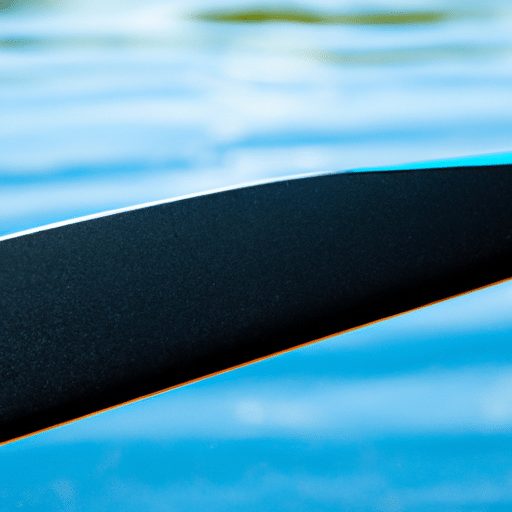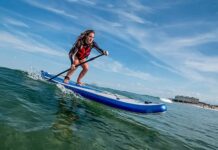Looking to get in shape while enjoying the tranquility of the water? In this article, we will explore the world of SUP fitness and answer one burning question: what kind of paddle do you need? Whether you’re new to stand-up paddleboarding or a seasoned pro, choosing the right paddle can make a world of difference. So let’s grab our boards and dive into the exciting realm of SUP fitness to uncover the paddle that will enhance our workout and maximize our performance on the water.
Choosing the Right Paddle for SUP Fitness
When it comes to stand-up paddleboarding (SUP) fitness, choosing the right paddle is essential for a comfortable and effective workout on the water. There are several factors to consider when selecting a paddle that is best suited for your SUP fitness needs, including paddle length, blade size, material, shaft, weight, grip, adjustability, and cost. In this article, we will discuss each of these factors in detail, providing you with the information you need to make an informed decision.
Paddle Length
The length of your paddle plays a crucial role in your SUP fitness experience. It is important to choose a paddle that matches your height and the type of paddling you intend to do. For SUP fitness, a slightly shorter paddle is often recommended compared to traditional paddleboarding. This is because a shorter paddle allows for a higher cadence, which is beneficial for cardiovascular workouts and repetitive movements. As a general guideline, the paddle should be around 8-10 inches taller than your height, although individual preferences may vary.
Paddle Blade Size
The size and shape of the paddle blade also have a significant impact on your efficiency and performance during SUP fitness sessions. Larger blade sizes provide more power but require more effort to paddle, while smaller blade sizes are ideal for lighter paddlers or those looking for a more leisurely workout. For SUP fitness, a medium-sized blade is typically recommended as it strikes a balance between power and ease of use. The shape of the blade can vary as well, with some blades having a more elongated shape for increased efficiency.
Paddle Material
The material of the paddle can affect its performance, durability, and weight. Common paddle materials include aluminum, fiberglass, carbon fiber, and plastic. Aluminum paddles are affordable and durable, making them a popular choice for beginners. However, they tend to be heavier and less efficient compared to other materials. Fiberglass paddles are lightweight, flexible, and offer a good balance between performance and cost. Carbon fiber paddles, on the other hand, are incredibly lightweight and provide excellent power transfer, but they come at a higher price point. Plastic paddles are the most durable but lack the performance and lightweight benefits of other materials.
Paddle Shaft
The shaft of the paddle refers to the part that connects the grip to the blade. It can be either a fixed or an adjustable length. A fixed shaft is ideal if you have a specific paddle length that works well for you and don’t anticipate needing to adjust it. Adjustable shafts, on the other hand, offer flexibility and are a great option if you plan to share your paddle or if multiple people of different heights will be using it. Consider the locking mechanism of the adjustable shaft as well, ensuring it is secure and doesn’t slip while paddling.
Paddle Weight
The weight of the paddle is another important factor to consider, especially during longer SUP fitness sessions. A lighter paddle will help reduce fatigue and allow you to maintain your form and technique for a more extended period. However, keep in mind that lighter paddles typically come with a higher price tag. It is essential to find a balance between weight and cost that suits your needs and budget.
Paddle Grip
The grip of the paddle is the part that you hold onto while paddling. It should feel comfortable, provide a secure hold, and allow for proper hand positioning during your SUP fitness routine. Grips can be made of various materials, including rubber, foam, or cork. Each material offers a different feel, so it is worth trying out different options to see which one suits you best. Additionally, ergonomic grips with contoured shapes can provide added comfort, especially during longer workouts.
Paddle Adjustability
As mentioned earlier, an adjustable paddle shaft allows for versatility in terms of length. However, it is also worth considering the adjustability of other parts of the paddle, such as the blade angle or the ability to switch between a straight or bent shaft. These features can enhance your SUP fitness experience by allowing you to customize the paddle to your preferences and workout goals.
Paddle Cost
Cost is an important factor for many when choosing a paddle. While it can be tempting to go for the cheapest option, it is essential to consider the quality, durability, and long-term value of the paddle. Investing in a higher-quality paddle may result in a more enjoyable and efficient SUP fitness experience. Consider your budget and research different options within that range, keeping in mind the features that are most important to you.
Recommended Paddle for SUP Fitness
Considering all the factors discussed, the recommended paddle for SUP fitness is a lightweight, adjustable paddle with a medium-sized blade. This type of paddle offers the versatility and comfort needed for an effective and enjoyable workout on the water. It allows you to adjust the length to your height, accommodates different users if needed, and provides a good balance between power and ease of use.
Remember, finding the right paddle is a personal choice, and what works for one person may not work for another. It is always recommended to try out different paddles before making a final decision. Consider renting or borrowing paddles from friends or local paddleboard shops to get a feel for different options. By taking the time to choose the right paddle, you can enhance your SUP fitness experience and make the most out of your time on the water. So grab your paddle, hit the water, and enjoy the many benefits of SUP fitness!





































